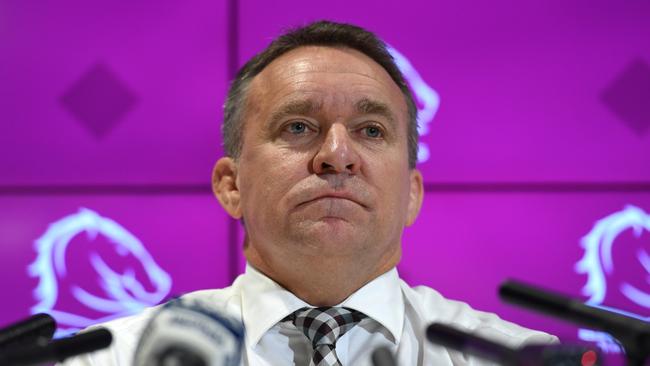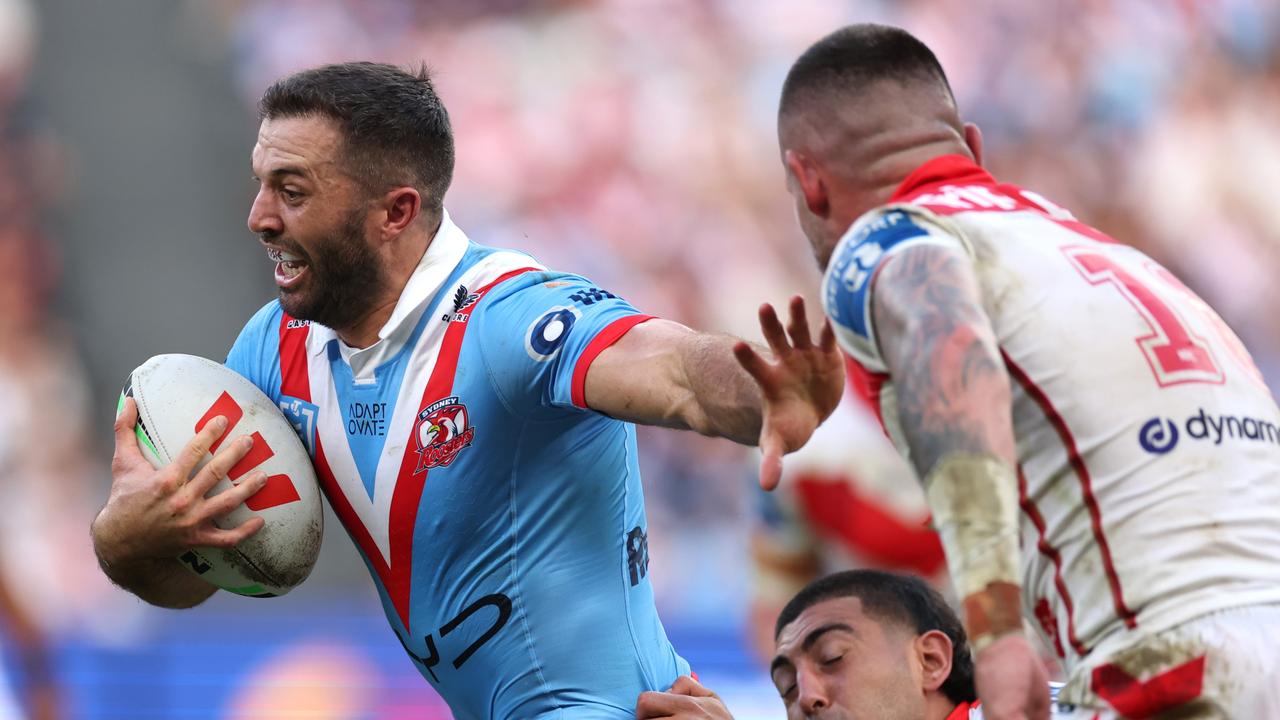Broncos lauded as NRL’s most efficient salary cap club
In an unprecedented study into the salary cap of the Broncos, the truth behind Brisbane’s financial management has been revealed. Read the full report here and see the list of player wages.
NRL
Don't miss out on the headlines from NRL. Followed categories will be added to My News.
BRISBANE have been hailed as the NRL’s most efficient club under the salary cap following revelations Origin star David Fifita heads into the finals on a cut-price salary of $250,000 this season.
Ahead of Brisbane’s final-round clash with the Bulldogs tonight in Sydney, The Courier-Mail has undertaken an unprecedented study of the salary cap landscape at the Broncos and the pay packets of their full-time squad in 2019.
BRONCOS v BULLDOGS: Not available on free-to-air TV, sign up now to Kayo Sports for your 14-day free trial >
For decades, there has been speculation around the salary cap activities of the code’s marquee clubs, headlined by the Broncos, the Roosters and the Storm.
Concerns about the salary cap have buffeted the Broncos since the early 1990s following the birth of the Thoroughbreds, a coterie of cashed-up businessmen who claimed to be offering life mentoring to Brisbane players.

Such suspicions were further fuelled in 2014 when Brisbane chief executive Paul White self-reported salary cap irregularities after $298,000 went missing from the Leagues Club books, allegedly to top-up the contracts of Broncos players.
The Broncos were ultimately cleared of any wrongdoing by the NRL.
And while they have never been found to have breached the salary cap, Brisbane’s ability to consistently retain elite talent, often at reduced rates, has triggered speculation about the prospect of creative accounting practices.
But a probe by The Courier-Mail shows the Broncos are cap compliant this season, with the club having outlaid an estimated $9.43 million this season. The 2019 NRL salary cap is $9.6 million.
That leaves a buffer of around $170,000, a financial insulation adopted by many NRL teams to fund contract bonuses or allow for an eleventh-hour player purchase.

There are three key factors that give the Broncos a distinct advantage over Sydney-based NRL teams in the salary cap space. They are:
● The cost of living in Brisbane compared to the expensive rat race in Sydney;
● Brisbane’s corporate sector with the Broncos’ monopoly in southeast Queensland enabling their best players to leverage third-party sponsorships; and
● An unwritten rule where a 20 per cent reduction is applied to player salaries during contract negotiations, giving the Broncos a huge leg-up.
The latter factor is a compelling trump card for the Broncos.
It works like this – an off-contract player at Brisbane is on a contract of $400,000. To consider moving him to a Sydney club, agents will apply a 20 per cent loading to factor in the cost of living in Australia’s biggest city.
It means Sydney clubs have to, in theory, pay more under the salary cap than Brisbane to be a realistic chance of poaching a Broncos player.

A classic case is Ben Hunt, who left the Broncos at the end of 2017 after receiving a massive offer from the Dragons worth $1 million a season.
“For example, if a Sydney club offers a Broncos player $500,000, many agents will view the Broncos offer of $400,000 as the same amount,” said a leading player manager.
“It means the Broncos can effectively offer 20 per cent less and still be on an even playing field to the Sydney clubs. It’s a huge advantage.”
The Broncos’ gravitas in Queensland makes it easier for players and agents to broker third-party agreements (TPAs) which are salary-cap exempt.
Last year, the NRL for the first time released TPA values.
Melbourne topped the league with more than $1 million in ancillary sponsorships. The Broncos were second with almost $800,000, more than triple the league’s TPA average of $264,000.
“The Brisbane commercial market is a powerful force,” said one agent.
“Unlike Sydney, where there are so many teams and players, there are probably only 10 players at the Broncos who are really marketable in the corporate space in Brisbane.
“So the big names at the Broncos can build a virtual microbusiness around their careers.
“The third-party opportunities for marquee players in Brisbane, such as a Darren Lockyer in the past, means there is rivers of gold outside the salary cap for the big names.
“The NRL salary cap is like the Tax Act. You have a number of rules for deductions and if you have a savvy accountant or tax agent, they are able to exploit it to optimise the way the rules are crafted.
“There’s a difference between rorting and optimising the salary cap ... and the Broncos do it better than anyone.”

Broncos football operations chief Peter Nolan and Brisbane company secretary Louise Lanigan can navigate the complex salary cap like a Formula One driver at Monaco.
By taking advantage of one such rule, the Broncos have legally received a $153,000 benefit this season.
Under salary cap rules, clubs who pay players $3000 in match fees in their rookie season have those payments declared cap exempt for 12 months only.
This year, Brisbane have blooded eight rookies, led by Tom Flegler (21 games) and Pat Carrigan (17).
Collectively, the slew of debutants have played 51 matches at $3000 a game – a $153,000 bonanza for the Broncos that is not counted by the NRL salary cap auditor.
That has enabled the Broncos space to retain the likes of Matt Lodge, Tevita Pangai Jr and Jake Turpin, who rejected more lucrative offers in the past two months to sign new deals at Red Hill.

“All of us could have got bigger money elsewhere but money isn’t everything,” Lodge said.
Fifita is evidence of Brisbane’s salary cap mentality. The Queensland Origin star is the value commodity of the season at $250,000.
In the coming months, the 19-year-old will look to sign an upgraded deal with Brisbane worth $700,000 annually, $300,000 shy of what he could elsewhere.
“You generally take less to be at the Broncos,” fellow teenage forward Payne Haas said. “That’s the way it is if you want to be successful as a group.”
While Brisbane possess a $1 million player on their books in Anthony Milford, most of their squad are on basic deals.
Of the 30-man full-time group, 17 earn less than $200,000 a season, including 2019 discovery Turpin, who plays halfback tonight on a meagre $90,000 deal.
Broncos coach Anthony Seibold admits there will be headaches in the coming years, when the likes of Kotoni Staggs, Fifita and Flegler warrant major upgrades.
“There will be some challenges with regards to other teams being interested in those young players,” he said.
“There is no doubt that there is interest in our players. One thing I believe the club does well is that there is a really strong retention committee that organises the salary cap very effectively.
“I am confident we will keep the players we want to keep but I also know there will be other clubs that will come in and want to take away some of the young talent that we have.”

ESTIMATED SALARIES OF BRISBANE’S FULL-TIME SQUAD FOR THE 2019 SEASON
Anthony Milford ––– $1,000,000
Jack Bird ––– $800,000
Darius Boyd ––– $700,000
Matt Gillett ––– $650,000
Andrew McCullough ––– $600,000
Matt Lodge ––– $500,000
Corey Oates ––– $500,000
Tevita Pangai Jr ––– $470,000
Alex Glenn ––– $400,000
Joe Ofahengaue ––– $360,000
Payne Haas ––– $310,000
Jamayne Isaako ––– $280,000
David Fifita ––– $250,000
Kotoni Staggs ––– $180,000
Tom Flegler ––– $160,000
George Fai ––– $150,000
Patrick Mago ––– $140,000
Gehamat Shibasaki ––– $140,000
Tom Dearden ––– $130,000
Sean O’Sullivan ––– $120,000
Pat Carrigan ––– $115,000
Shaun Fensom ––– $100,000
Izaia Perese ––– $100,000
Sam Tagataese ––– $100,000
Jake Turpin ––– $90,000
Cory Paix ––– $85,000
Troy Dargan ––– $80,000
Herbie Farnworth ––– $80,000
Richie Kennar ––– $72,500
James Segeyaro ––– $72,500
TOTAL ––– $8,735,000
RELEASED PLAYERS THIS SEASON: James Roberts, Jaydn Su’A, Jordan Kahu, Josh McGuire and Kodi Nikorima.
COMBINED PRO-RATA SALARY IN CAP: $698,000*
(*Note: NRL players are paid monthly starting November 1 each year)
DEVELOPMENT PLAYERS: Ethan Bullemor, Xavier Coates (left), Rhys Kennedy, Keenan Palasia, Ilikena Vudogo. (Receive $60,000 each, salary cap exempt payments for all clubs)
GRAND TOTAL $9,433,000
2019 SALARY CAP: $9,600,000**
** $9.3 million ceiling, plus extra $200,000 for Veteran and Developed Player Allowance (VDPA), and $100,000 for five cars to nominated players at $20k each.


